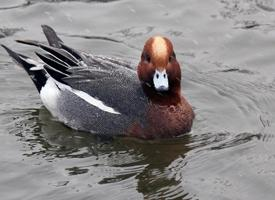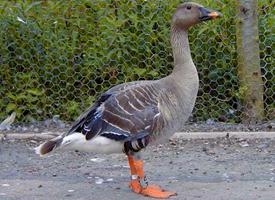
Poids et mesures
| Hauteur au garrot | de 42 à 50 cm |
|---|---|
| Poids | de 400 à 1090 g |
| Envergure des ailes | de 71 à 80 cm |
Description de l'animal
The Eurasian Wigeon, scientifically known as Mareca penelope, is a captivating and colorful species of dabbling duck that is widely distributed across the northern reaches of Europe and Asia, with its wintering grounds extending into Africa and the Indian subcontinent. This medium-sized bird exhibits a fascinating combination of physical attributes and behaviors that make it a subject of interest among birdwatchers and ornithologists.Adult males of the species are particularly striking during the breeding season, adorned with a distinctive breeding plumage that sets them apart from their female counterparts and other duck species. The male's head is a rich chestnut color, crowned with a creamy-yellow forehead and fore crown, giving it a distinguished appearance. The eyes are dark, adding a touch of intensity to their gaze. Their body is predominantly grey, finely patterned with subtle lines that provide an elegant contrast against the more vivid colors of the head. The breast is a soft pink, transitioning to a white underbelly. One of the most notable features is the male's conspicuous black rear end, accented by a broad white patch that is visible when the bird is in flight. The wings are graced with a distinctive green speculum bordered by white, which is particularly noticeable during flight and serves as a key identification feature.
Females and non-breeding males are more subdued in coloration, with mottled brown plumage that serves as excellent camouflage among the marshes and wetlands they inhabit. Despite their more inconspicuous appearance, females share the same green speculum as males, though it is less pronounced.
Eurasian Wigeons are highly gregarious outside of the breeding season, often forming large flocks that can include thousands of individuals. They are known for their distinctive whistling calls, which add a melodic backdrop to their habitats. These calls play a crucial role in social interactions and are especially prominent during the mating season.
In terms of habitat, Eurasian Wigeons are highly adaptable, frequenting a wide range of wetlands including marshes, lakes, estuaries, and coastal bays. Their diet is predominantly vegetarian, feeding on a variety of aquatic plants, grasses, and occasionally grains, which they typically forage for by dabbling at the water's surface or grazing on land. This diet contributes to their preference for habitats that offer an abundance of vegetation.
The breeding season prompts a remarkable migration for many populations, with birds traveling from their wintering grounds in southern regions to breeding sites in the northern tundra and taiga zones. During this time, they favor shallow bodies of freshwater where they can construct nests hidden among dense vegetation, demonstrating a preference for security and seclusion.
The Eurasian Wigeon plays a significant role in its ecosystem, contributing to the control of aquatic vegetation and serving as prey for a variety of predators, including foxes, large birds of prey, and humans. Despite facing threats from habitat loss and hunting, the species remains relatively abundant, owing to its wide distribution and adaptability.
In summary, the Eurasian Wigeon is a fascinating and vibrant species, embodying the beauty and complexity of avian life. Its striking appearance, intriguing behaviors, and the melodious whistles that fill the air make it a cherished sight in the wetlands and waterways it calls home.
Animaux similaires
Nouvelles photos d'animaux
Top 10 des animaux
- Dolphin gull (Leucophaeus scoresbii)
- Diana monkey (Cercopithecus diana)
- Moustached guenon (Cercopithecus cephus)
- Galápagos tortoise (Geochelone nigra complex)
- Stone loach (Barbatula barbatula)
- Japanese macaque (Macaca fuscata)
- Russian tortoise (Testudo horsfieldii)
- Greek tortoise (Testudo graeca)
- Common flying dragon (Draco volans)
- Vendace (Coregonus albula)


